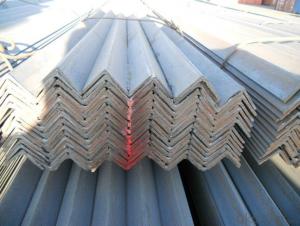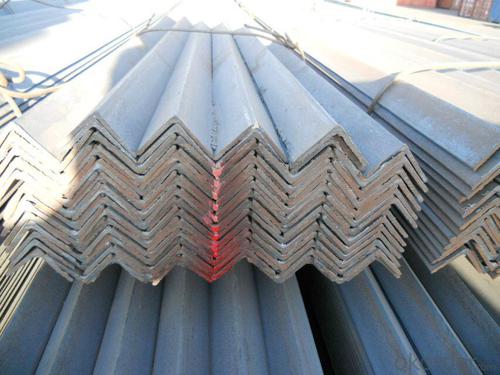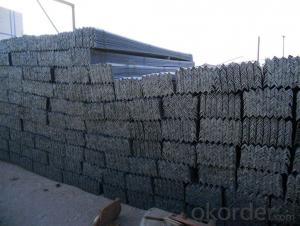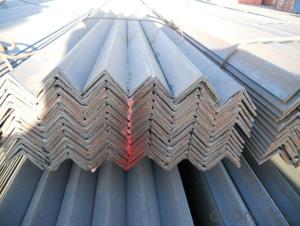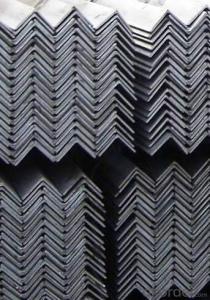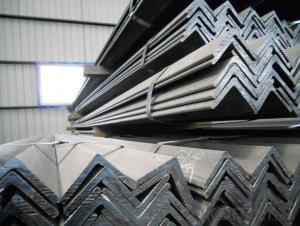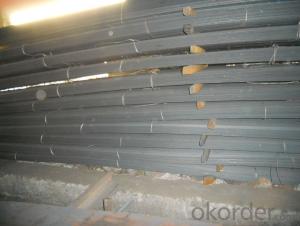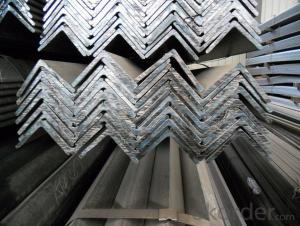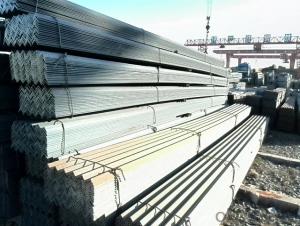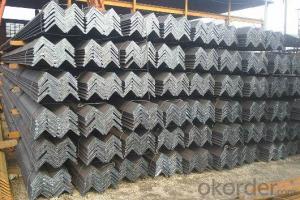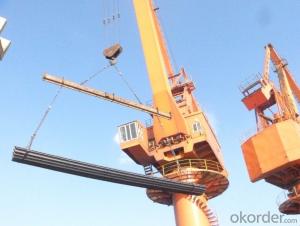Wholesale Hot Rolled Equal Angle Steel in Stock
- Loading Port:
- Tianjin
- Payment Terms:
- TT OR LC
- Min Order Qty:
- 25 m.t.
- Supply Capability:
- 10000 m.t./month
OKorder Service Pledge
OKorder Financial Service
You Might Also Like
Specification
OKorder is offering high quality Hot Rolled Steel Angle at great prices with worldwide shipping. Our supplier is a world-class manufacturer of steel, with our products utilized the world over. OKorder annually supplies products to European, North American and Asian markets. We provide quotations within 24 hours of receiving an inquiry and guarantee competitive prices.
Product Applications:
Hot Rolled Steel Angle are ideal for structural applications and are widely used in the construction of buildings and bridges, and the manufacturing, petrochemical, and transportation industries.
Product Advantages:
OKorder's Steel Angle are durable, strong, and resist corrosion.
Main Product Features:
· Premium quality
· Prompt delivery & seaworthy packing (30 days after receiving deposit)
· Corrosion resistance
· Can be recycled and reused
· Mill test certification
· Professional Service
· Competitive pricing
Product Specifications:
Manufacture: Hot rolled
Grade: Q195 – 235
Certificates: ISO, SGS, BV, CIQ
Length: 6m – 12m, as per customer request
Packaging: Export packing, nude packing, bundled
Sizes: 25mm-250mm | ||
a*t | ||
25*2.5-4.0 | 70*6.0-9.0 | 130*9.0-15 |
30*2.5-6.6 | 75*6.0-9.0 | 140*10-14 |
36*3.0-5.0 | 80*5.0-10 | 150*10-20 |
38*2.3-6.0 | 90*7.0-10 | 160*10-16 |
40*3.0-5.0 | 100*6.0-12 | 175*12-15 |
45*4.0-6.0 | 110*8.0-10 | 180*12-18 |
50*4.0-6.0 | 120*6.0-15 | 200*14-25 |
60*4.0-8.0 | 125*8.0-14 | 250*25 |
FAQ:
Q1: Why buy Materials & Equipment from OKorder.com?
A1: All products offered byOKorder.com are carefully selected from China's most reliable manufacturing enterprises. Through its ISO certifications, OKorder.com adheres to the highest standards and a commitment to supply chain safety and customer satisfaction.
Q2: How do we guarantee the quality of our products?
A2: We have established an advanced quality management system which conducts strict quality tests at every step, from raw materials to the final product. At the same time, we provide extensive follow-up service assurances as required.
Q3: How soon can we receive the product after purchase?
A3: Within three days of placing an order, we will begin production. The specific shipping date is dependent upon international and government factors, but is typically 7 to 10 workdays.
Images:
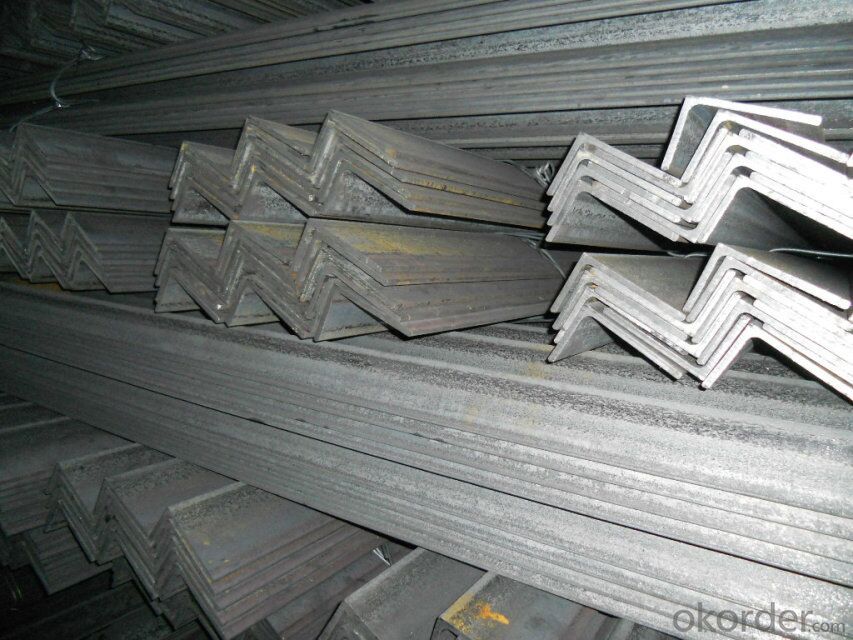
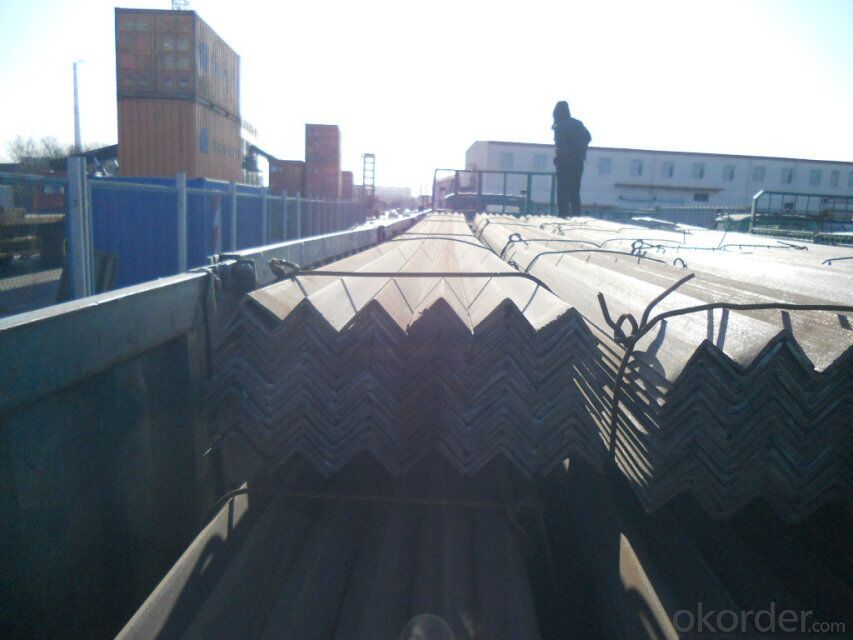
- Q: Can steel angles be used for transportation infrastructure projects?
- Yes, steel angles can be used for transportation infrastructure projects. Steel angles are commonly used in the construction of bridges, highways, and railway structures due to their strength, durability, and ability to withstand heavy loads. They provide necessary support and stability to various components of transportation infrastructure, making them an ideal choice for such projects.
- Q: How do steel angles contribute to the overall lateral stability of a structure?
- The overall lateral stability of a structure is improved by steel angles in various ways. Firstly, they serve as bracing members to counteract lateral forces like wind or seismic loads. By linking the angles to the building's main structural components, they assist in distributing these forces and preventing the structure from collapsing or deforming under the applied load. Additionally, steel angles can be utilized as stiffeners to boost the stiffness and rigidity of crucial structural parts. By incorporating angles into beams, columns, or other elements, their resistance to bending or buckling is heightened, thereby enhancing the overall lateral stability of the structure. Moreover, steel angles can act as shear connectors between different structural elements. For instance, by welding or bolting angles to beams, they establish a connection that facilitates the transfer of shear forces between the components. This is essential for ensuring that the structure remains stable and capable of withstanding lateral loads without significant deformation or failure. Furthermore, steel angles can be employed as diagonal members in truss systems. By forming diagonal bracing, they aid in evenly distributing the applied loads across the structure, preventing excessive lateral displacements and maintaining the overall stability of the building. In conclusion, steel angles play a crucial role in enhancing the lateral stability of a structure. Their application as bracing members, stiffeners, shear connectors, and diagonal members all contribute to distributing and resisting lateral forces, guaranteeing that the structure remains stable and capable of withstanding external loads.
- Q: Can steel angles be used in the construction of staircases?
- Indeed, staircases can be constructed using steel angles. Due to their strength and versatility, steel angles are frequently employed as structural elements in construction. In the context of staircases, steel angles serve to offer support and stability to the entire structure. They can establish the framework for the stairs, providing support for the treads and risers. Moreover, steel angles can serve as handrails or guardrails, ensuring a firm and safe grip for users. All in all, steel angles are a favored option for staircase construction due to their durability, capacity to bear loads, and aesthetic attractiveness.
- Q: How are steel angles installed?
- Installing steel angles is a straightforward process that involves a few basic steps. To begin, mark the desired location for the angle on the surface or structure where it will be installed. Use a level and measuring tape to ensure proper alignment and mark the positions for the screw or bolt holes. Once the markings are complete, it is necessary to pre-drill the holes using a drill bit slightly smaller than the screws or bolts you will use. This prevents the steel angle from cracking or splitting during installation. After pre-drilling, place the steel angle back in position and align the holes with the markings on the surface. Use a wrench or screwdriver to securely tighten the screws or bolts, ensuring the angle is firmly attached. To ensure a successful installation, it is essential to follow the manufacturer's instructions and recommendations for the specific type and size of steel angle. Additionally, verify that the surface or structure can support the weight and load it will bear. In summary, steel angles are easy to install and offer excellent structural support in a variety of applications, including construction, manufacturing, and DIY projects.
- Q: What are the common surface treatments used for steel angles?
- The common surface treatments used for steel angles are galvanizing, painting, and powder coating. Galvanizing is a process where a layer of zinc is applied to the surface of the steel angle to protect it from corrosion. This is achieved by immersing the steel angle in a bath of molten zinc or by applying a zinc coating using a specialized technique. Galvanized steel angles have a shiny, silver appearance and provide excellent corrosion resistance. Painting is another commonly used surface treatment for steel angles. The steel angle is typically primed and then coated with one or more layers of paint. This not only enhances the aesthetic appeal of the steel angle but also provides a protective barrier against rust and other environmental factors. Painting allows for a wide range of color options and finishes, making it a versatile choice for various applications. Powder coating is a dry finishing process where a fine powder, typically made of resin and pigment, is electrostatically applied to the steel angle's surface. The angle is then heated, causing the powder to melt and form a durable coating. Powder coating offers excellent resistance to scratches, chemicals, and UV rays. It is available in a wide array of colors and provides a smooth and even finish. The choice of surface treatment for steel angles depends on the specific application and the desired level of protection, aesthetics, and durability. Galvanizing is preferred in outdoor or corrosive environments, while painting and powder coating are commonly used for indoor applications or where a specific color or finish is desired.
- Q: What are the different types of steel angles used in bridge construction?
- Bridge construction commonly utilizes various types of steel angles that serve vital roles in providing structural support and stability to the bridge. 1. Equal Leg Angles, also referred to as L-shaped angles, possess two legs of equal length forming a 90-degree angle. These angles support and reinforce the bridge components during construction. 2. Unequal Leg Angles, as implied, have two legs of different lengths forming a 90-degree angle. These angles are frequently employed in bridge construction to accommodate specific design requirements and support varying loads. 3. Bulb Angles are unique angles characterized by a bulb-shaped leg. They enhance the strength and rigidity of the bridge structure, particularly in areas expected to experience high stress or heavy loads. 4. Inverted Angles are similar to equal leg angles, but their orientation is inverted, with the longer leg positioned at the bottom. These angles provide additional support and stability, especially when the bridge must withstand lateral forces. 5. Fillet Welded Angles are angles joined together using fillet welds. Their purpose in bridge construction is to establish robust and durable connections between different bridge components, ensuring structural integrity and stability. Each steel angle type possesses distinct properties and advantages, rendering them suitable for specific applications in bridge construction. The selection of the appropriate angle type depends on factors such as load requirements, span length, design specifications, and structural considerations. Professional engineers and designers diligently evaluate these factors to determine the most suitable steel angle for a given bridge construction project.
- Q: How do steel angles compare to other structural shapes like beams and channels?
- Steel angles, beams, and channels are all common structural shapes used in construction. While beams and channels are primarily used to carry loads in horizontal applications, steel angles are versatile and can be used in both horizontal and vertical applications. Unlike beams and channels, steel angles have two legs that form a 90-degree angle, providing greater stability and resistance to bending. Additionally, steel angles are often more cost-effective than beams and channels due to their simpler design. However, the choice between steel angles, beams, and channels ultimately depends on the specific requirements of the project and the loads they need to support.
- Q: What are the design considerations for using steel angles in architectural applications?
- Some design considerations for using steel angles in architectural applications include structural stability, load-bearing capacity, aesthetic appeal, corrosion resistance, and ease of installation. Steel angles are commonly used to provide support, reinforcement, and stability to various architectural elements such as beams, columns, and frames. The selection of the appropriate size, thickness, and grade of steel angle is crucial to ensure the structural integrity and safety of the building. Additionally, architects may consider the visual impact of steel angles, as they can be exposed or concealed depending on the design intent. The corrosion resistance properties of the steel angles should also be taken into account, especially in applications where exposure to moisture or harsh environments is expected. Lastly, the ease of installation and compatibility with other building materials should be considered to streamline the construction process.
- Q: How do steel angles perform in terms of thermal expansion and contraction?
- Steel angles have a relatively low coefficient of thermal expansion, which means they expand and contract less compared to other materials when subjected to temperature changes. This property makes steel angles highly stable in terms of thermal expansion and contraction. Consequently, they are widely used in various structural applications where temperature variations are expected. Steel angles provide structural integrity and stability, even in environments with significant temperature fluctuations, making them a reliable choice for construction and engineering projects.
- Q: Can steel angles be used for manufacturing window frames?
- Yes, steel angles can be used for manufacturing window frames. Steel angles are commonly used in construction and fabrication due to their strength and durability. They provide structural support and can be easily welded or bolted together to create window frames that are sturdy and long-lasting.
Send your message to us
Wholesale Hot Rolled Equal Angle Steel in Stock
- Loading Port:
- Tianjin
- Payment Terms:
- TT OR LC
- Min Order Qty:
- 25 m.t.
- Supply Capability:
- 10000 m.t./month
OKorder Service Pledge
OKorder Financial Service
Similar products
Hot products
Hot Searches
Related keywords
